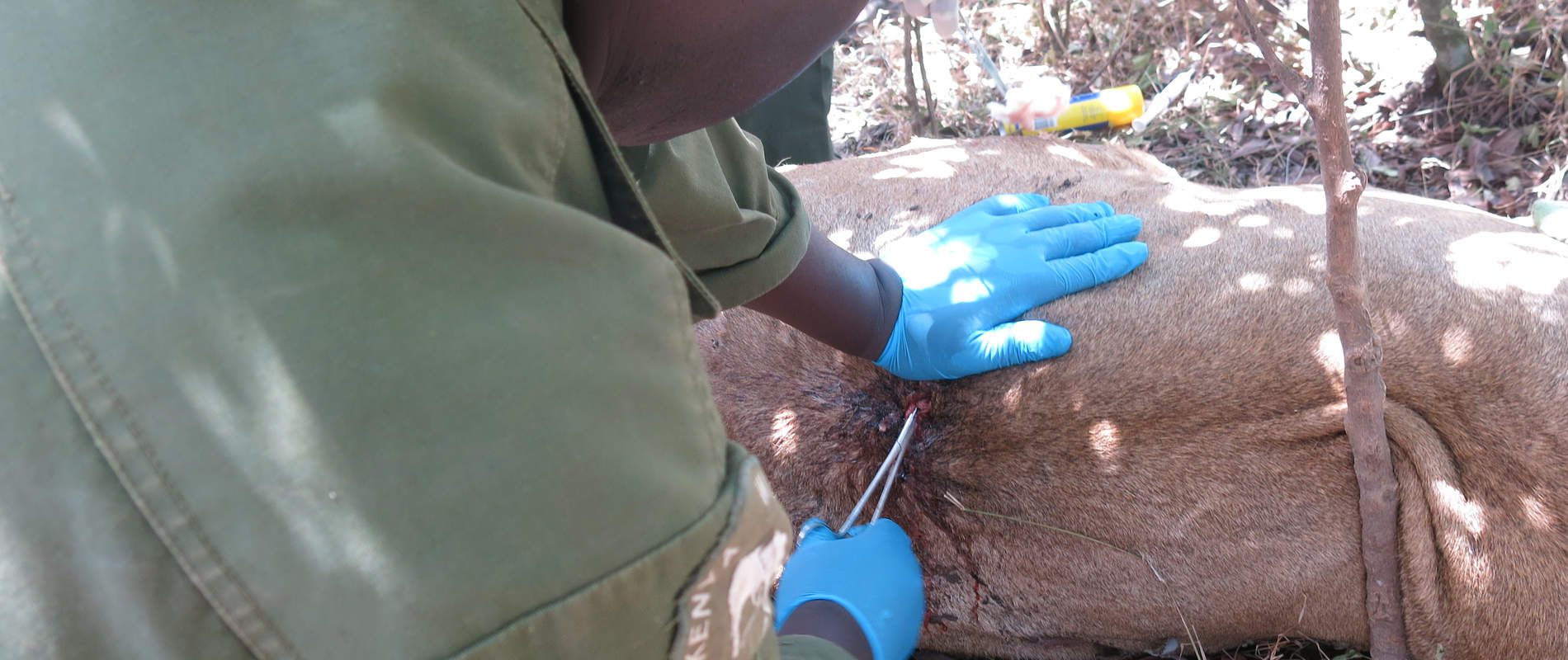MARA FIELD VETERINARY REPORT-OCT 2015 By Dr
MARA FIELD VETERINARY REPORT-OCT 2015
By Dr. Campaign Limo
Introduction
The month experienced moderate precipitation with most of the wild animals moving out of the park to Conservancies and Community areas. There has been notable increase in elephant – human conflicts most likely caused by close interaction of humans, livestock and wildlife species due to competition for resources. One of the two cheetahs treated for suspected cat flu succumbed to the condition while the brother continued to improve and finally recovered and is now living a healthy life. Results from the samples collected are still being awaited.
The following are veterinary cases handled during the month;
CASE#1 ELEPHANT WITH A SPEAR WOUND
Date: 9th Oct 2015
Species: African elephant
Age: Adult
Sex: Male
Location: Keekorok, Masai Mara National Reserve
History
This massive bull was seen with spear wound to the left side of his flank discharging purulent stuff by County Government staff and visiting tourists. They called the unit for intervention.
The Unit found the elephant in the open near a waterpoint in the company of an equally massive bull just a few meters away. He appeared to be in great pain and reluctant to move. The wound was visible from a distance.
Immobilization, examination and treatment
Chemical restraint was achieved by administration of 16mgs Etorphine hydrochloride delivered through a 3ml Dan inject dart from a vehicle. He was prevented from going into a nearby thicket using vehicles and guided towards a more open area. It took eight minutes for the drugs to take full effect with this bull assuming left lateral recumbency. He had to be flipped over using a vehicle and ropes in order to access the injured side.
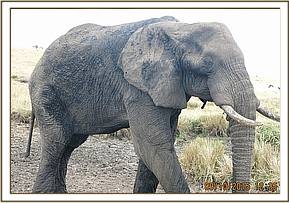

There was an approximately four day old injury to his left flank which was infected, discharging purulent stuff and appeared to have been caused by a spear. The depth was not beyond the abdominal muscles though there was moderate tissue necrosis. All necrotic tissues were removed and the pus drained. The wound was debrided with Hydrogen peroxide, rinsed with clean water then lavaged with tincture of iodine and finally green clay was packed into the wound to absorb toxins and hasten healing. Additional treatments involved parenteral administration of 30000mgs Amoxicillin antibiotic and 5000mgs Flunixin meglumine anti-inflammatory.


Reversal
Achieved by administration of 42mgs diprenorphine hydrochloride through ear vein. He rose in four minutes and joined his colleague.
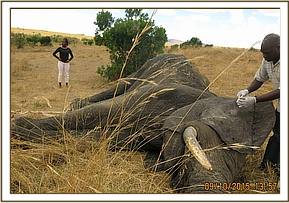

Prognosis
This bull is expected to make a full recovery.
CASE#2 DE-SNARING AND TREATMENT OF AN ADULT MALE RHINO
Date: 10th Oct 2015
Species: Black Rhino (Diceros bicornis)
Sex: Male
Age: Adult
Location: Ruma National park
History
This adult male christened Baraka, was seen dragging a braided wire attached to a log in the morning by the park security team. This raised concern and all efforts were made to rescue this stressed rhino. This involved arranging a Vet team from KWS headquarters to be flown via Mara to pick the Mara Vet in order to assist in the de-snaring.
This rhino was still alert and in a difficult terrain to approach by vehicle. He had dropped the log but the wire was tightly round his neck.
Immobilization, de-snaring and treatment
This rhino was immobilised using a combination of 5mgs Etorphine hydrochloride and 80mgs Azaperone in a 1.5ml Dan inject dart from foot due to the nature of the terrain. It took approximately ten minutes for the drugs to take full effect and the rhino movement was monitored all along by a fixed wing plane which guided the ground team to the location of the rhino. Breathing was stabilized by intravenous administration of 5mgs Butorphanol before the wire was cut loose. The resultant wound was cleaned with Hydrogen peroxide, rinsed with clean water and then disinfected with Iodine. Oxytetracycline spray was then applied topically. This rhino received Amoxicillin antibiotic and Flunixin meglumine anti-inflammatory; all given parenterally.


Reversal
Reversal of the anaesthetic was achieved by administration of 18mgs Diprenorphine and 100mgs Naltrexone into a prominent ear vein. He got to his feet after ten minutes and disappeared into the tall grass.
Prognosis
Good.
CASE#3 TREATMENT OF A SPEARED ELEPHANT BULL
Date: 12th Oct 2015
Species: African elephant
Sex: Male
Age: 40-45yrs
Location: Olkinyei conservancy
History
This massive bull was seen by KWS security team together with Olkinyei Conservancy staff hardly mobile with blood tinged exudate from a wound to his left flank. They called the Mobile veterinary unit for assessment and way forward.
This bull was alone in a relatively open area. He appeared to be in great pain and reluctant to move. A relatively fresh wound with bloody discharge was visible on his left flank. The urine he released at the time of observation appeared to be blood tinged. A decision to immobilize him for further examination was arrived at.
Immobilization, examination and treatment
He was chemically restrained by use of 16mgs Etorphine hydrochloride delivered through a 3ml Dan inject dart from a vehicle. It took a total of eight minutes for the drugs to take full effect with the elephant assuming left lateral recumbency.
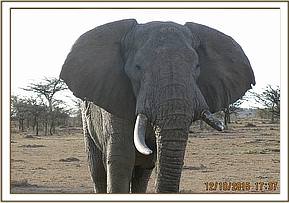

Quick examination revealed another sharp wound mid spine, inflicted by a sharp object most likely a spear. This however did not damage the spinal cord. This wound was thoroughly lavaged with water, Hydrogen peroxide to remove debri, rinsed with clean water and swabbed dry before tincture of iodine was applied to disinfect the area. Thereafter green clay was applied to prevent sepsis and absorb toxins.


After the first wound was treated, the elephant was flipped over using ropes and a vehicle in order to assess the wound to the left flank. This was a deep wound that accessed the peritoneum and the left kidney. No offending object was retrieved as probing yielded nothing. The wounds were wiped with sterile swabs and disinfected with tincture of iodine before Penicillin and Streptomycin were infused. The wound was then packed with green clay. He was given 30000mgs Amoxicillin antibiotics and 5000mgs Flunixin meglumine anti-inflammatory all parenterally.
Reversal
Reversal of the anaesthetic was achieved by administration of 48mgs Diprenorphine hydrochloride intravenously through the ear vein and 150mgs Naltrexone intramuscularly.
After making a few attempts, it was evident this elephant could not stand without help. He was roped and assisted to stand with a vehicle where he eventually rose and walked towards a thicket.
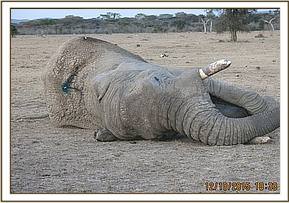

Prognosis
Due to the involvement of the peritoneum and left kidney, prognosis was considered grave and sadly, this massive bull succumbed 24hrs after intervention. There was extensive left kidney damage and peritonitis. Both tusks were recovered and taken by KWS security staff for accounting and safe custody.
CASE#4 TREATING AN INJURED YOUNG LION
Date: 13th Oct 2015
Species: African lion
Age: Sub - Adult
Sex: Male
Location: Mara North Conservancy (Mara Royal Camp)
History
This young male was injured by the mother of a baby hippo that it was hunting. He took refuge at the camp attracting sympathies of the visitors. Subsequently Mara North Conservancy rangers requested the Unit’s services to treat this young male.
This young male is about three years old and was found relaxing a few meters from the camp in a small thicket. He moved with a lot of pain with wounds visible to his left hind leg.
Immobilization, examination and treatment
Restraint was achieved chemically by use of combination of 3.2mgs Medetomidine and 230mgs Ketamine delivered through a 3ml Dan-inject dart from a vehicle. He moved briefly before settling down in a small bush.
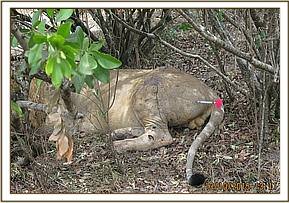

The drugs took full effect after ten minutes and a blindfold was put in place. Cloxacillin eye ointment was put on both eyes before the wounds were examined. He had bite wounds to his left rump and groin area with some abrasions to the left hind limb. All the wounds were consistent with hippo bites. Luckily there was no damage to internal organs and the wounds were relatively fresh.
All the wounds were debrided with Hydrogen Peroxide, rinsed with clean water, wiped dry with sterile gauze swabs and disinfected with tincture of iodine. Cloxacillin ointment antibiotic was also infused into the wounds. In addition, this lion received an intramuscular injection of 3000mgs Amoxicillin antibiotic and 16mgs Dexamethasone Sodium anti-inflammatory. To reduce parasitic infestation and prevent maggot colonization, he was also given a subcutaneous injection of 70mgs Ivermectin.
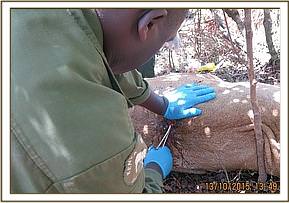

Reversal
Reversal of the anaesthetic was achieved by administration of 12.5mgs Atepamezole hydrochloride intramuscularly one hour after immobilization. He rose up seven minutes after revival and moved to sit under another shade.
Prognosis
Good
CASE#5 DESNARING A BABY ELEPHANT
Date: 16th Oct 2015
Species: African elephant
Sex: Male
Age: 3yrs
Location: MMNR
History
This snared baby elephant was reported by Masai Mara National Reserve (MMNR) rangers on patrol. The Unit found the calf near a Lugga wallowing with his mother close by but no other elephants in proximity. A braided cable wire was wrapped around his neck though not very tight. His condition was still good.
Immobilization, de-snaring and treatment
Immobilization was achieved by use of 3mgs Etorphine hydrochloride delivered through a 1.5ml dan-inject dart from foot. Both the mother and the calf were pushed out of the Lugga into the open. As soon as the calf succumbed to the drug the mother was moved away by vehicles while the vet team concentrated on removing the snare. It was a braided cable wire which had caused mild abrasion wounds to the neck which were cleaned and disinfected with iodine. He also received 3000mgs intramuscular injection of amoxicillin antibiotic.
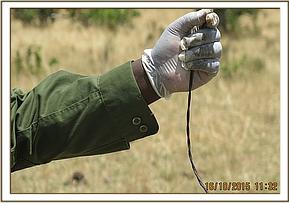

Reversal
Reversal of the anaesthetic was achieved by administration of 12mgs Diprenorphine hydrochloride through the ear vein. He rose after two minutes and joined his mother.
Prognosis
Good.
CASE#6 TREATING AN INJURED LION
Date: 17th Oct 2015
Species: African lion
Age: Adult
Sex: Male
Location: Musiara area
History
This big male christened Blackie and his equally big brother are frequently seen near double cross in MMNR. On the 17th October Blackie was seen with multiple bite wound injuries to his hindquarters by Governors Camp guides and MMNR rangers who called the Vet Unit for assistance. It was likely that he picked a fight with other males over territorial competition. His brother was nowhere to be seen.
The Vet Unit found Blackie alone near a Lugga lying down and in a lot of pain. His hindquarters bore multiple bite wounds with blood stains. The right hind limb appeared to be severely injured and not weight bearing.
Immobilization, examination and treatment
He was chemically immobilized by use of a combination of 4mgs Medetomidine and 260mgs Ketamine delivered through a 3ml Dan inject dart from a vehicle. It took ten minutes for him to be fully anaesthetized. A blind fold was used to cover his eyes and Cloxacillin eye ointment applied to prevent desiccation.


Examination revealed multiple fresh wounds to the rear part of his body and to the gluteal muscles consistent with bites from other lions. All the wounds were cleaned with sterile water, wiped dry with sterile gauze swabs, disinfected with tincture of Iodine and infused with Cloxacillin ointment.
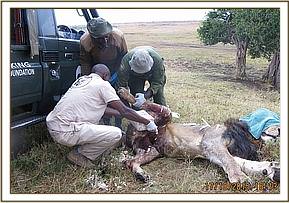

He was also given an intramuscular administration of 3000mgs Amoxicillin antibiotic and 16mgs Dexamethasone sodium anti-inflammatory.
Reversal
Reversal of the anaesthetic was achieved by intramuscular administration of 15mgs Atepamezole one hour after immobilization. He got to his feet ten minutes after reversal, moved briefly before sitting down again.


Prognosis
Good
CASE#7 DESNARING A GIRAFFE
Date: 18th Oct 2015
Species: Masai giraffe
Age: Adult
Sex: Female
Location: Mara Triangle Conservancy
History
This young giraffe was seen with a snare around the leg on the extreme western border of Mara Triangle Conservancy near the escarpment and reported to the Vet Unit by Conservancy management. The Unit found this giraffe in a small herd limping on her left hind limb with a snare around her distal metacarpus. Her condition was still good and she could be seen browsing.
Immobilization, examination and de-snaring
Immobilization was achieved by use of a combination of 8mgs Etorphine hydrochloride and 50mgs Azaperone delivered in a 1.5ml dan-inject dart from a vehicle. It took seven minutes for the drugs to take full effect with the giraffe assuming right lateral recumbency.
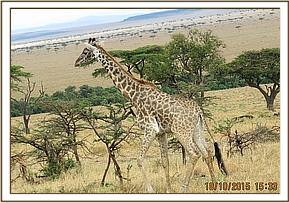

The wire, which had become loose overtime, was released and the abrasion wounds treated. The wounds were disinfected with tincture of Iodine and Oxytetracycline spray applied topically. She also received intramuscular administration of 4500mgs Amoxicillin anti-biotic to prevent sepsis.


Reversal
Reversal of the anaesthetic was achieved by administration of 24mgs Diprenorphine hydrochloride intravenously through the jugular vein. She rose immediately and took off to join the rest of the herd.


Prognosis
Good.
CASE#8 ASSESSMENT OF AN ELEPHANT WITH INJURED TOE
This big bull in Mara Triangle Conservancy was seen close to the snared giraffe. His left forelimb had a fresh wound to one of the inner toes caused by loss of the nail. Further examination revealed this elephant had been treated a couple of months ago for a snare that was tight around this limb. The limb had since healed and the fresh wound was thought to have been caused by accidental knock on a rock or tree stump. He was in good condition and showed no signs of lameness or pain. There was a small wound which should heal without intervention. However the rangers were advised to monitor this elephant and report back if it gets worse.

CASE#9 TREATMENT OF A ELEPHANT WITH AN ARROW WOUND
Date: 21st Oct 2015
Species: African elephant
Age: Adult
Sex: Male
Location: Naboisho conservancy
History
This massive bull was seen in the company of several other males. An arrow head was protruding from his left thigh and Naboisho Conservancy Management called the mobile Vet Unit for assistance. The bull was in very good condition and was browsing a slight distance from the other bulls.


Immobilization, examination and treatment
Restraint was achieved by administration of 17mgs Etorphine hydrochloride through a 3ml dan-inject dart from a vehicle. It took nine minutes for the drugs to take full effect with the elephant assuming sternal recumbency. He was pushed over onto his right side.
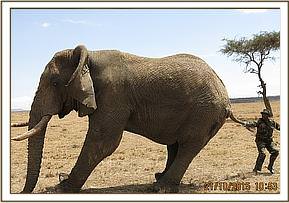

The arrow head, which appeared to have been in place for at least 24 hours, was worked out. It was barbed and not poisoned.
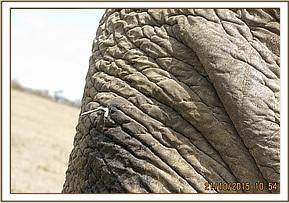

The resultant wound was debrided with Hydrogen peroxide, rinsed with clean water and flushed with tincture of Iodine. In addition, he received parenteral administration of 30000mgs Amoxicillin antibiotic and 2500mgs Flunixin meglumine anti-inflammatory.


Reversal
Reversal of the anaesthetic was achieved by administration of 48mgs Diprenorphine hydrochloride and 100mgs Naltrexone intravenously through superficial ear veins. He rose up after four minutes and joined the other bulls.
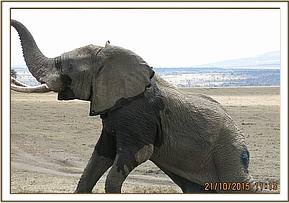

Prognosis
Good.
Conclusion
The Mara Mobile Veterinary Unit is grateful to all stakeholders who helped report and monitor animals requiring veterinary intervention during the month. Many thanks to the Minara Foundation through DSWT for their continued facilitation to the unit. Thanks too to KWS management for their guidance and technical support to the unit. All your inputs have helped the unit respond to veterinary emergencies well and saved lives that would have otherwise been lost.
